Protein
Adequate protein intake is essential to help minimise declines in strength and function. High protein supplements can help reduce complications and improve weight.27,28
THE CRUCIAL ROLE OF MUSCLE CONSEQUENCES OF LOW MUSCLE MASS MEASURING AND PREVENTING MUSCLE LOSS THE IMPORTANCE OF MUSCLE SCREENING THE IMPORTANCE OF MEDICAL NUTRITION ABBOTT’S RANGE OF NUTRITIONAL SUPPLEMENTS EDUCATIONAL RESOURCES
Chronic obstructive pulmonary disease (COPD) imposes a substantial daily burden on individuals with the disease, which not only includes the physical manifestations of the disease, but also the significant impact living with COPD can have on patients’ quality of life. The majority of COPD patients report that their symptoms impact their daily activities and often lead to sleep disturbances, heightened anxiety and depression.3
Poor prognosis, reduced quality of life, hospitalisation, and mortality risks are often higher in COPD patients with muscle dysfunction.4
Up to 39% of COPD patients experience reduced skeletal muscle mass5 caused by factors such as frequent or prolonged use of COPD medication (Corticosteroids), systemic inflammation, and other comorbidities.2,5-7
COPD in itself is characterised by an obstructed or chronically limited airflow.8 COPD patients often experience increased energy expenditure due to hypermetabolism (an elevated resting energy expenditure), caused by increased respiratory muscle effort, added oxygen requirements and lower food intake.8,9
In fact, for people living with COPD, just breathing can require 10x more energy than someone without COPD.10 In addition, people with COPD often experience a reduced appetite associated with limited exercise, depression or experiencing a feeling of being unable to breathe whilst eating (dyspnea).11,12
Hypermetabolism is a key cause of muscle loss in COPD patients:6,7,13
When the body is in a stressed state, it requires more amino acids from muscle breakdown leading to accelerated protein loss. Patients with low muscle mass have difficulty coping with metabolic stress, negatively impacting survival, and recovery.14
Extended periods of immobilisation, such as during acute hospitalisation, can worsen muscle loss and prolong recovery. If muscle loss persists before the body enters a stressed state, restoring normal function becomes unlikely.14
Low muscle mass affects both ventilatory and non-ventilatory muscle groups in COPD patients and is linked to altered nutritional status, which can impact disease progression. Malnutrition and muscle loss can lead to:2,4,15-17
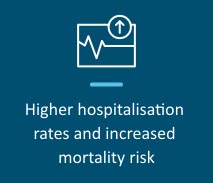



As COPD progresses, a significant burden can also be placed on the patients’ family and/or carers, impacting their own physical health, emotional, social, relational and financial aspects of their life.18

Stress on carer–patient relationship quality

Carers’ emotional distress (i.e. anxiety and depression symptoms)

Carers’ mental health

Carers' physical health
COPD patients can experience accelerated muscle loss and muscle dysfunction early in the disease, which, combined with the progression of respiratory impairment, is linked to altered nutritional status.15,17 These changes can influence disease progression, so early assessment and intervention is critical to improve outcomes.2,15
Should go beyond pulmonary function by also considering physical performance and general health19
Muscle loss can increase with disease severity but can affect even stable patients20
Exercise capacity in COPD patients is often limited by alterations of skeletal muscle, rather than pulmonary problems, but can be improved through pulmonary rehabilitation, decreasing the risk of hospitalisation16,21
The European Respiratory Society recommends muscle screening as an integrative part of the routine assessment of people with COPD.22 NICE guidelines also recommend BMI is calculated for all patients with COPD with close attention to unintentional weight loss.23
Muscle screening and assessments often take limited time to apply in clinical practice and are typically non-invasive, inexpensive and convenient for the patient.24,25
Screening can easily identify limited strength and performance, a strong predictor of adverse negative health outcomes and can be easily used to increase physical activity and implement nutrition interventions.25,26
Various reliable screening methods exist to assess the risk of malnutrition and muscle loss.25
Early use of ONS should be considered for those at risk of malnutrition to ensure further weight loss is prevented, improve functional measures and positively affect patient outcomes.2
Key nutrients can improve muscle health amongst COPD patients:
Adequate protein intake is essential to help minimise declines in strength and function. High protein supplements can help reduce complications and improve weight.27,28
HMB is a metabolite of leucine, a branched-chain essential amino acid exclusively obtained from dietary sources29
Vitamin D acts directly on muscle to promote its function through specific vitamin D receptors found on muscle cells. It plays an important role in maintaining musculoskeletal health and can help reduce the risk of falls and improve mobility.29-32
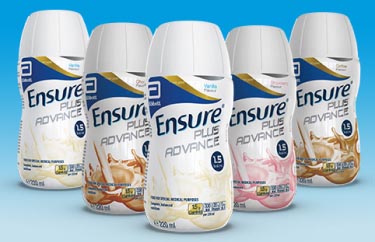

Ensure Plus Advance§ is a 220ml, ready to drink ONS. It contains a unique blend of protein, vitamin D and HMB that improves patient strength, increases body weight and reduces the risk of mortality in COPD patients.°,34 It is the high protein, high energy ONS people prefer to drink vs. a high protein compact*,†,35,36 and achieves 96% compliance.^,37
Validated by more than 18 clinical studies34,37-55, Ensure Plus Advance is proven to significantly increase strength, mobilisation rates and wound healing and has also been shown to improve quality of life in various patient populations.**,††,‡‡,§§,¶,¶¶,~,#,34,37,41-43,45,48,50
The unique blend of protein, vitamin D and HMB in Ensure Plus Advance has been shown to reduce the risk of death by 71% in malnourished patients with COPD and is clinically proven to improve strength and shorten immobilisation periods in various patient populations.**,§§,||,34,45, 49
Abbott’s range of ONS has been developed to help patients with other nutritional needs.
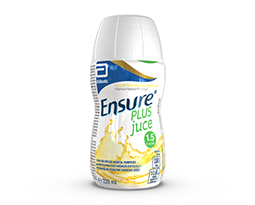
Ensure Plus juce
Ensure Plus juce is a 1.5 kcal/ml, ready-to-drink, juice style oral nutritional supplement for people with, or at risk of developing, disease-related malnutrition. Ensure Plus juce is best served chilled and is available in six flavours: apple, fruit punch, lemon and lime, orange, peach and strawberry. It's presented in a 220 ml bottle with a peel-off seal for pouring.
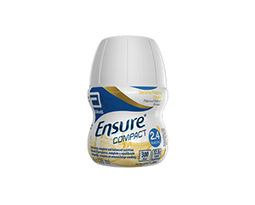
Ensure Compact
Ensure Compact is a 125 ml, ready-to-drink, nutritionally complete§ oral nutritional supplement for people with, or at risk of developing, disease-related malnutrition. Its small volume has been specially developed for people who have difficulty drinking larger volumes or who have a poor appetite. Each easy-to-open Ensure Compact bottle1 provides 300 kcal (2.4 kcal/ml) and 12.8 g of protein.
Ensure Compact is available in 4 delicious flavours; banana, café latte, strawberry and vanilla.
§Nutritionally complete for vitamins and minerals in 625 ml (excluding sodium, potassium, chloride and magnesium). Calculated using the UK Reference Nutrient Intake for men aged 19-50 years.
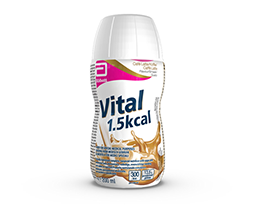
Vital 1.5kcal
Vital 1.5kcal is suitable for people with disease-related malnutrition and malabsorption or for those who experience symptoms of poor feed tolerance. Vital 1.5kcal is peptide-based* and available both as a 200 ml oral nutritional supplement, and as a 1000 ml Ready to Hang tube feed, both of which attach directly to Abbott giving sets. Oral nutritional supplement flavour options include: café latte, mixed berry and vanilla.
*Peptides are partially broken down proteins, which makes them easier to digest and absorb in the gut than whole proteins.
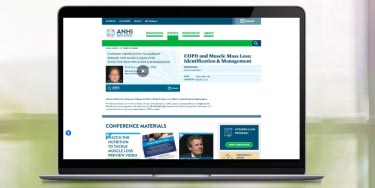

On-demand webinar — Respiratory disease and muscle: nutritional interventions to support our patients
Philip Atherton, PhD describes the importance of muscle in patients with respiratory disease; explains how muscle is lost, the detrimental consequences of muscle loss, and why maintaining and rebuilding muscle can improve outcomes, and reviews nutritional interventions to support patients in maintaining muscle.
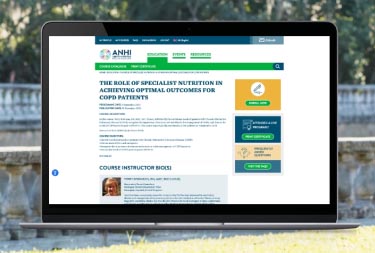

On-demand webinar — The role of specialist nutrition in achieving optimal outcomes for COPD patients
In this course, Terry Robinson, RN, MSc, BSc (Hons), will identify the nutritional needs of patients with COPD, recognising the importance of exercise and nutrition management of COPD patients.
UK-N/A-2300361 (V2) | January 2024
Footnotes
COPD - Chronic obstructive pulmonary disease. HMB - ß-hydroxy-ß-methylbutyrate. NFkB - Nuclear factor kappa B. § ACBS indication: as a nutritional supplement for frail elderly people (>65 years of age, with a BMI ≤ 23kg/m2), where clinical assessment and nutritional screening show the individual to be at risk of undernutrition. ° Based on a post-hoc analysis of the NOURISH Study, a multicentre, randomised, placebo-controlled, double-blind trial. The COPD subgroup (n = 214) included hospitalised, malnourished, older adults (≥65 years), with Ensure Plus Advance] (n = 109) or standard-of-care and a placebo supplement (n = 105) prescribed 2 servings/day from within 3 days of hospital admission (baseline) and up to 90 days after discharge. * Vs. market-leading high protein compact. †243 healthy adults who were asked to drink comparative flavours of Ensure Plus Advance and Fortisip Compact Protein. ^ Research with 80 healthy women over 65 years of age supplemented with one serving of Ensure Plus Advance daily for 8 weeks. ** As shown in a randomised control trial to investigate the effects of the intervention ONS on malnourished, cardiopulmonary patients (≥65 years) vs placebo. The intervention ONS decreased mortality at 90 days post-discharge, however the study did not observe a significant effect for the primary composite endpoint of non-elective readmission or death. This post-hoc, sub-group analysis from the NOURISH study cohort comprised 214 COPD patients. ††Strength was measured by handgrip strength in a post hoc analysis of over 600 malnourished people with heart or lung diseases, age 65 or older. Study product was consumed twice a day for 30 days, as compared to standard of care. ‡‡ In 330 older adults with malnutrition and sarcopenia. Muscle quality was calculated as leg strength expressed relative to the muscle mass. §§ As shown in a randomised control trial to investigate the effects of a specialised ONS on older women (≥65 years) who underwent surgery for hip fracture vs. standard post-operative nutrition. Post-operative nutrition provided 1900 kcal and 76 g protein a day. Muscle function was measured by handgrip strength. Mobilisation status was assessed on post-operative days 15 and 30. ¶An open-label study of elderly (n=35) patients with recent weight loss (>5% during previous 3 months) showed that 12 weeks supplementation of experimental product twice daily increased dietery intake, biochemical variables, and quality of life compared to baseline. ¶¶In 65 healthy older female patients who regularly attended a fitness programme. ~As shown in a randomised controlled trial in which normally nourished patients with non-cystic fibrosis bronchectasis received pulmonary rehabilitation plus a specialised ONS or pulmonary rehabilitation only for 12 weeks. In the intervention group, mean and maximum handgrip dynamometry, physical functioning domain of QOL-B-V3.0 and other outcomes were significantly increased from baseline at 12 weeks and 24 weeks and fat free mass at 12 weeks. #In a single arm open-label study of 148 patients aged 80±8.3 years with or at risk of malnutrition who consumed experimental product twice daily for 12 weeks as compared to baseline. ||In 92 patients aged 65 and over with hip fractures admitted to a rehabilitation facility, either receiving a standard diet plus 2 bottles of the study product or a standard diet only. Standard diet provided 1500 kcal, 87.4 g protein a day.
References
1. Orozco-Levi M. Eur Respir J 2003;22(46):41s-51s. 2. Malnutrition Pathway, 2020. Managing Malnutrition in COPD: Including a pathway for the appropriate use of ONS to support community healthcare professionals. Available online: https://www.malnutritionpathway.co.uk/library/mm_copd.pdf. Last accessed August 2023. 3. Miravitlles M. & Ribera A. Respiratory Research 2017:18:67. 4. Jaitovich A. & Barreiro E. Am J Respir Crit Care Med 2018;198(2):175–186. 5. Abdulai RM. et al. Am J Respir Crit Care Med 2018;197(4):433-449. 6. King PT. Clin Transl Med 2015;4:26. 7. Fermoselle C. et al. Eur Res J 2012;40(4):851-862. 8. Ramires BR. et al. Nutrition Journal 2012;11:37. 9. Steyn FJ. et al. J Neurol Neurosurg Psychiatry 2018;89:1016-1023. 10. American Lung Association, 2023. Nutrition and COPD. Available online: https://www.lung.org/lung-health-diseases/lung-disease-lookup/copd/living-with-copd/nutrition Last accessed October 2023. . 11. Itoh M. et al. Nutrients 2013;5:1316-1335. 12. Hashmi MF. et al. Dyspnea. In: StatPearls [Internet]. Treasure Island (FL): StatPearls Publishing; 2023 Jan. Available from: https://www.ncbi.nlm.nih.gov/books/NBK499965/. 13. Rawal G. & Yadav S. Journ Trans Int Med 2015;3(4):151–154. 14. Wolfe RR. Am J Clin Nutr 2006;84:475-82. 15. Fekete M. et al. Physiol Int 2021;108(2):238-250. 16. Wüst R. & Degens H. Int J Chron Obstruct Pulmon Dis 2007;2(3):289-300. 17. Passey SL. et al. Pharmacol Ther 2016;116:56-70. 18. Cruz J. et al. Health Soc Care Community 2017;25(1):11-25. 19. Safka KA. et al. Chronic Obstr Pulm Dis 2017;4(1):45 55. 20. Jones SE. et al. Thorax 2015;70(3):213-218. 21. Corhay J. et al. Int J COPD 2014;9:27-39. 22. Marklund S. et al. Int J Chron Obstruct Pulmon Dis 2019;14:1825-1838. 23. NICE, 2018. Chronic obstructive pulmonary disease in over 16s: diagnosis and management. Available online: https://www.nice.org.uk/guidance/ng115/chapter/recommendations Last accessed October 2023. 24. Beaudart C. et al. Calcif Tissue Int 2019;105,1–14. 25. Cruz-Jentoft A. et al. Age Ageing 2019;48(1):16–31. 26. Murayama I. et al. Aging Clin Exp Res. 2020;32, 913–920. 27. Deutz NE. et al. Clin Nutr 2014;33(6):929-936. 28. Cawood AL. et al. Ageing Res Rev 2012;11(2):278-296. 29. Wilson GJ. et al. Nutr Metab 2008;5:1. 30. Wagatsuma A. & Sakuma K. Biomed Res Int 2014;2014:121254. 31. European Food Safety Authority. EFSA J 2010;8(2):1468. 32. European Food Safety Authority EFSA J 2011;9(9):2382. 33. Zhu K. et al. J Am Geriatr Soc 2010;58(11):2063-2068. 34. Deutz NE. et al. Clin Nutr 2021;40(3):1388-1395. 35. Data on file. Abbott Laboratories Ltd, 2023 (Ensure Plus Advance acceptability and compliance vs Fortisip Compact Protein). 36. IMS Data, July 2023. 37. Berton L. et al. PloS one 2015;10(11):e0141757. 38. Ashkenazi I. et al. Geriatr Orhop Surg Rehabil 2022;13:21514593221102252. 39. Chavarro-Carvajal DA. et al. Clin Nutr ESPEN 2022;48:291-297. 40. Cornejo-Pareja I. et al. Nutrients 2021;13(12):4355. 41. Cramer JT. et al. JAMDA 2016;17(11):1044-1055. 42. De Luis DA. et al. Eur Geriatr Med 2018;9(6):809-817. 43. De Luis DA. et al. Nutr Hosp 2015;32(1):202-207. 44. Deutz NE. et al. Clin Nutr 2016;35(1):18–26. 45. Ekinci O. et al. Nutr Clin Pract 2016;31(6):829-835. 46. Espina S. et al. Nutrients 2021;13(11):3764. 47. Lopez-Rodriguez-Arias F. et al. Support Care Cancer 2021;29(12):7785-7791. 48. Matheson EM. et al. Clin Nutr 2021;40(3):844-849. 49. Malafarina V. et al. Maturitas 2017;101:42-50. 50. Olveira G. et al. Clin Nutr 2016;35(5):1015-1022. 51. Peng LN. et al. J Nutr Health Aging 2021;25(6):767-773. 52. Previtali P. et al. Ann Surg Oncol 2020;27(6):2025-2032. 53. Ritch CR. et al. J Urol 2019;201(3):470–477. 54. Standley RA. et al. J Gerontol A Biol Sci Med Sci 2020;75(9):1744-1753. 55. Zana S. et al. J Am Med Dir Assoc 2021;22(7):1358-1360.
You are about to exit for another Abbott country or region specific website.
Please be aware that the website you have requested is intended for the residents of a particular country or region, as noted on that site. As a result, the site may contain information on pharmaceuticals, medical devices and other products or uses of those products that are not approved in other countries or regions.
The website you have requested also may not be optimised for your specific screen size.
Do you wish to continue and exit this website?
UK-N/A-2200465 | July 2022
UK-N/A-2200443 | June 2022
Stay Connected